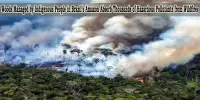The combination of wildfire smoke and urban air pollution brings out the worst in each other. Wildfire smoke contains a combination of gaseous pollutants (for example, carbon monoxide), hazardous air pollutants (HAPs) (for example, polycyclic aromatic hydrocarbons [PAHs]), water vapor, and particle pollution. Particle pollution is a major component of wildfire smoke and the primary public health risk.
As flames rage, their burned fuel transforms into a complicated chemical mix of smoke. As wind blows the smoking smoke over cities, many of these airborne components, including ozone, cause air quality to drop. But, according to Joel Thornton, an atmospheric scientist at the University of Washington in Seattle, the exact way and extent to which wildfire emissions contribute to ozone levels downwind of the fires has been a source of contention for years.
A new study has discovered the enigmatic chemistry underpinning the generation of ozone in wildfire plumes. Researchers write in Science Advances that combining wildfire smoke with nitrogen oxides — hazardous chemicals present in car exhaust — could raise ozone levels in metropolitan areas.
Many ozone-making elements, such as volatile organic compounds and nitrogen oxides, can be found in wildfire smoke. We developed a simple equation to determine ozone production from wildfire emissions using these parameters, as well as wind patterns and fuel from each wildfire tested.
Lu Xu
Ozone in the atmosphere is a primary component of smog, which can cause respiratory difficulties in humans and wildlife. Many ozone-making elements, such as volatile organic compounds and nitrogen oxides, can be found in wildfire smoke, according to Lu Xu, an atmospheric chemist presently working at the National Oceanographic and Atmospheric Administration Chemical Sciences Laboratory in Boulder, Colo. A list of components, however, is insufficient to duplicate a wildfire’s ozone recipe. As a result, Xu and his colleagues traveled to the skies to see the chemistry in action.
The researchers collaborated with NASA and NOAA on a cooperative endeavor to transform a jetliner into a flying laboratory as part of the Fire Influence on Regional to Global Environments and Air Quality flight campaign. The airplane team took air samples from smoldering landscapes across the western United States in July and August 2019. As the plane flew through the plumes, onboard instruments recorded the types and amounts of each molecule discovered in the cloud. The scientists examined how the chemical makeup of the plume varied over time by weaving in and out of the smoke as it traveled downwind from the fires.

The researchers developed a simple equation to determine ozone production from wildfire emissions using these parameters, as well as wind patterns and fuel from each wildfire tested. “We took a hard question and gave it a simple answer,” explains Xu, who worked on the project while studying at Caltech.
The researchers discovered that wildfire emissions contain a dazzling diversity of organic chemicals and nitrogen oxide species, among other components that contribute to ozone production, just as they expected. Nonetheless, their investigation revealed that the concentration of nitrogen oxides diminishes in the hours following the plume’s sweep downstream. Without this critical component, ozone generation is significantly slowed.
Cities and other metropolitan places pollute the air with poisonous gases. When wildfire smoke wafts over cityscapes, a surge in nitrous oxides could re-ignite ozone production, according to Xu.
In a typical fire season, these mixtures might raise ozone levels by up to 3 parts per billion in the western United States, according to the study. Although this concentration is well below the U.S. Environmental Protection Agency’s health safety threshold of 70 parts per billion, Xu believes that the incremental increase could still represent a health risk to persons who are often exposed to smoke.
Because climate change is increasing the frequency and intensity of wildfires, this novel ozone production method has significant implications for urban air quality, according to Qi Zhang, an atmospheric scientist at the University of California, Davis who was not involved in the work. According to her, the research fills a “important gap” between wildfire emissions and ozone chemistry.
According to Thornton, who was not engaged in the research, the findings may also represent a challenge to environmental policymakers. Despite the fact that state and local governments have rigorous rules in place to limit atmospheric ozone, he believes that wildfire smoke may undercut their efforts. Despite air quality rules, this could make it more difficult for communities, particularly in the western United States, to achieve EPA ozone criteria.
















